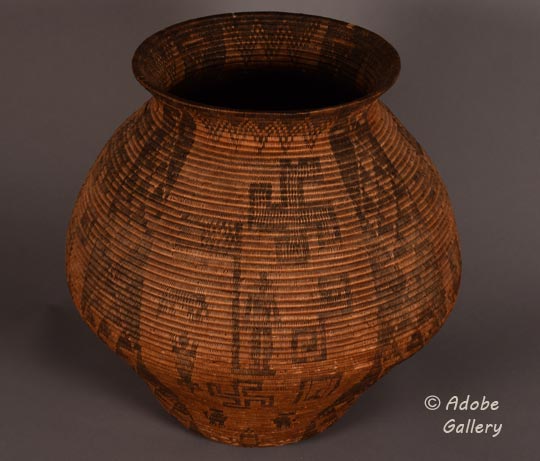Very Large Yavapai Apache Basket OLLA, circa 1900
+ Add to my watchlist Forward to Friend
Forward to Friend
- Category: Ollas or Jars
- Origin: Apache, American Indians
- Medium: willow, mulberry, devil’s claw
- Size: 21” height x 20” diameter
- Item # C4839C
- Price Available On Request
This Western Apache basket storage jar, or olla, is excessively large and commanding with remarkable designs. It measures 21 inches in height and 20 inches at its maximum width. From the flat base on which it rests, the wall expands outward to the midpoint of the olla, and then gracefully slopes inward to the point where the rim curves out. The diameter of the base is 10-½" the widest point of the body is 20",the cincture at the neck is 11-½" and the rim diameter is 13-½".
According to Clara Lee Tanner in Apache Indian Baskets (p. 113), "There is some question as to whether the jar was a form developed by Apaches for Apaches—or for the white man. . . Several researchers have not observed jars in use in the wickiups of these Indians". Whether for use or for sale is not important. What is important is the beauty achieved by the weaver on such a large scale.
This basket was divided into sections for design placement. Four dark bands run vertically from base to rim. In each black band are diamonds containing stacked black triangles (arrow heads?). Pictorial elements fill the areas between the black bands. There are animals, pairs of humans, corn plants, humans on horseback, an American flag on a flagpole, a very tall man wearing a hat, and several whirling log or swastika symbols. These designs float over the basket wall.
A little history of Apache basketmaking reveals some interesting facts. Because the Western Apache made little if any pottery, they needed baskets for transporting everything from grain to firewood, and for use in meal preparation. During the final decades of the nineteenth century and the early years of the twentieth, the magnificent, coiled baskets of Western Apache were eagerly sought by collectors. Contact with whites severely disturbed the Apache's traditional pattern, but baskets began to gain a new importance with the development of a market among occupying troops on the reservation and steadily encroaching settlers. A number of basketry innovations developed in response to the cash market, but most of the changes were modifications of traditional shapes and designs. [Whiteford, 1988:63]
The Western Apache consists of five individual Apache tribes, one of which is the Tonto. It has been quoted from a statement by Mrs. J. S. Newman (not identified) the Tonto should rank first as the best basket makers. They made chiefly ollas, which require more skill than plaques or bowl shapes, and their work is universally even and good. Their specimens are nearly always marked with the arrow point, the pattern running vertically from the center. (This comment came from a 1904 book by Mason) Ibid, p.63
Unfortunately, Mason does not illustrate any Tonto baskets or describe them in further detail. The statement about arrow points leads us to question whether these are arrow points in the dark vertical bands on this large olla. If so, is this one of the Tonto basket ollas? By the 1880s, the Western Apache were designing most of their baskets to please and attract white customers, and the large, visible designs became their most popular products. Certainly this olla, with an American Flag, was intended for one of the military persons at the time.
"Around the turn of the century, Western Apache women briefly made coiled ollas in many shapes and sizes, but the production of large baskets declined soon after 1900 because smaller baskets were more profitable. . . Many of the large ollas are about 20 to 24 inches high, and some are as tall as 36 inches or more." Ibid, 82
We recently receive the following information from Diane Dittemore:
I loved seeing the amazing coiled olla identified as Western Apache. I have just published [the] book Woven from the Center: Native Basketry of the Southwest (UA Press, 2024), that expands upon the scholarship of beloved Clara Lee Tanner to whom the book is dedicated. In it I argue that the type of baskets with lots of negative designs and including the whirling cross (that native basket weavers in conversations have rejected being called swastikas) are likely to have been woven by Yavapai weavers. I am not the first person to attach these design choices to Yavapai, and fully understand the complex relationship between Yavapai and Western Apache people who were interned together at San Carlos. Suggesting Yavapai as a possible culture of manufacture is, from my research, fully justified. As for Tonto Apache, this name actually was at times given to Yavapai! - Diane Dittemore, Associate Curator, Arizona State Museum
Condition: good condition with some missing stitches on the underside.
Provenance: this Very Large Yavapi Apache Basket OLLA, circa 1900 is from the collection of a resident of Santa Fe
References:
- Tanner, Clara Lee. Apache Indian Baskets, The University of Arizona Press, Tucson, 1982
- Whiteford, Andrew Hunter. Southwestern Indian Baskets - Their History and Their Makers, SAR Press, Santa Fe, 1988
TAGS: Native American Baskets, Apache, American Indians

- Category: Ollas or Jars
- Origin: Apache, American Indians
- Medium: willow, mulberry, devil’s claw
- Size: 21” height x 20” diameter
- Item # C4839C
- Price Available On Request
Adobe Gallery Recommended Reading
Adobe Gallery Recommended Items
If you are interested in this item, we would also like to recommend these other related items:



